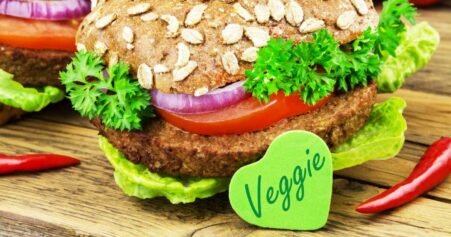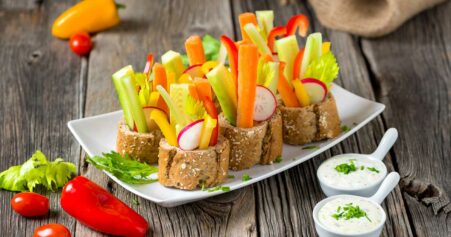Table of Contents
Vegan cream helps you to not miss”the icing on the cake”. It is not just the proverbial cherry on top. Often, a dollop of cream rounds out a dish perfectly, or is used as a filling in some cakes.
As a vegan, do you have to do without? Of course not! Because vegan cream is not inferior to cream from cow’s milk. In this article, you get to know the best vegan cream alternatives.
Did you know …
… that the fat content is the main factor that determines how well cream whips?
What is Cream?
Cream is made by centrifuging milk into skim milk and cream. Cream is then obtained from the latter and the fat content is adjusted by mixing it with skim milk (Rimbach et al., 2015). There are legal regulations which specify the composition, production and labeling of cream. These specifications vary slightly from country to country. Depending on the cream variety, the fat content is about 10 to 35 % (German Federal Ministry of Justice and Consumer Protection, 1970; legislation.gov.uk, 1995).
Vegan Cream Alternatives
Vegan Cream is available made from soy, oat, rice, almond and coconut bases. Other ingredients are added to achieve the desired texture. Depending on the composition, vegan cream can be used as cooking cream or whipped into vegan whipping cream. Because the ingredients and compositions vary, the nutritional values vary accordingly. Even if the taste differs slightly from animal cream in some cases, this is usually not noticeable after processing in food (for example in sauces). Used on its own, the additional flavor nuance makes, for example, whipped cream even more delicious.
Due to the strict regulations in some countries, vegan cream substitutes cannot be labeled as “vegan cream”. Depending on the country, different regulations allow different names.
Vegan Cream for Cooking
An alternative for cream for cooking is usually available in tetra packs or (plastic) cups. The main ingredient is mostly water. Depending on the variety, oats, soybeans, coconut extract, almonds, rice or even lentil protein are added. An oil is also added, often sunflower oil, sometimes rapeseed or palm oil. Thickening agents and, if necessary, stabilizers and emulsifiers are used to achieve the right consistency. Sweeteners such as sugar, glucose syrup or agave syrup are added, depending on the base used and the intended use. A pinch of salt rounds out the flavor.
The approximate range of nutritional values for vegan cooking cream is shown in Table 1.
Table 1: Nutritional values of vegan cream per 100g
| Energy | 90-180 kcal |
| Fat | 7-20 g |
| Carbohydrates | 2-6 g |
| Protein | 1-3 g |
Vegan Whipping Cream
You can whip vegan whipping cream, but you can also add it to sauces, stir-fries, and ice cream. On the one hand, it comes in a long-lasting powder form or liquid in a carton, which does not require refrigeration. On the other hand, you can (rarely) find fresh whipped cream, which requires refrigeration. Since it is not preserved by heating, it has a shelf life of only a few days and must be used quickly after opening.
By the way: You can freeze the vegan whipping cream after whipping. So it is easy to prepare and there is no need to throw it away when you have made too much.
Durable Vegan Whipping Cream
It comes in powder form and consists of sugar, salt, starch and other thickeners, and in some cases rice protein is added. If you choose this option, you simply add the powder to some (homemade) vegan milk alternative and whip the whole thing. The advantage of the powder is that it can be stored for a long time without refrigeration, it takes up little space, you usually have a vegan milk alternative in the house anyway, and it is quick to prepare. In addition, when you use a fortified drink, you also get some micronutrients. This is not the case with liquid whipping cream in a Tetrapak. It consists of water and oil, mostly palm kernel oil. The ingredients list also often includes dextrose, a sweetener, emulsifiers and starch, as well as stabilizers and acidity regulators, salt and flavoring. You can choose between sweetened and unsweetened products. If you choose the unsweetened version, you can decide how sweet you want it yourself.
Vegan whipping cream also comes with different nutritional values. The macronutrient and calorie content is lower than in the animal version, as you can see in Table 2.
Table 2: Average Nutritional Values of Vegan whipping Cream per 100 g
| Energy | 160-270 kcal |
| Fat | 15-30 g |
| Carbohydrates | 4 g |
| Protein | 0 g |
Fresh Vegan Whipping Cream
While you can often find shelf-stable vegetable whipping cream in the supermarket, the fresh version is still a rarity. The base usually is an almond or soy beverage. A vegetable fat (for example coconut or palm), a sweetener (for example apple syrup or sugar), thickeners and emulsifiers are added. Examples of nutritional values are listed in Table 3.
Table 3: Nutritional Values of Fresh Whipping Cream per 100 g
| Energy | 250-320 kcal |
| Fat | 23-34 g |
| Carbohydrates | 2-10 g |
| Protein | 1 g |
As you can see, the calorie and fat content is relatively high. On the other hand, the almond drink and coconut oil are slightly more nutritious than the water and palm oil in the unrefrigerated version.
Vegan Whipped Cream
You can save yourself the whipping process by opting for ready-to-use vegan whipped cream. There are products based on water and vegetable fat, and products based on soy or rice. The list of ingredients includes for example water/rice/soy drink, (palm kernel) oil/fat, dextrose, (sugar), emulsifiers, propellants, humectants, stabilizers, starch, flavoring, and sometimes soy protein isolate. Thus, the ingredients are similar to those of animal origin, except that the milk fat is replaced with a vegetable fat. However, neither the animal nor the vegan versions are environmentally friendly. Again, the vegan whipped cream is usually lower in fat. Table 4 shows examples of the nutritional values of vegan whipped cream.
Table 4: Nutritional Values of Vegan Whipped Cream per 100 g
| Energy | 200 kcal |
| Fat | 16 g |
| Carbohydrates | 15 g |
| Protein | 0 g |
Alternatives to Vegan Cream
The use of palm and coconut fats is a negative aspect of ready-made cream substitutes: their production is associated with negative environmental consequences. If you use products containing these fats, make sure they come from sustainably certified sources. There are also alternatives, such as canned coconut milk: For sauces or soups, use as is; for creams or whips, place in the refrigerator overnight and open carefully. Then pour off the water that has selected on top (this can be used in smoothies, for example). Now you can either use the solid part immediately as a cream substitute for creams in vegan desserts or cakes, or you can whip it with a hand mixer or food processor. You can add vegan cream stiffener and/or powdered sugar if desired. Alternatively, you can whip aquafaba (the cooking liquid from chickpeas) with baking powder, a little lemon juice, and powdered sugar.
Tips on How To Use Vegan Cream
In general, you can use the vegan cream in the same way as the version of animal origin, for example in soups, casseroles, sauces, curries, creams for vegan desserts, cakes, pies or ice cream. How well the whipping works depends on the ingredients and fat content. So here are a few tips to make whipping successful:
- Place both the cream and the bowl in the refrigerator for several hours before using.
- Use an electric hand mixer or food processor.
- Whip the cream for a few minutes. Patience is required.
- If necessary, add some vegan cream stiffener (“Sahnesteif”/”Whip it”).
Our Conclusion on Vegan Cream
In contrast to the product of animal origin, vegan cream is usually lower in fat. It also does not sour as quickly, so you can keep it for longer. The different varieties offer variation, so everyone can find their favorite. In addition, with a little experience and practice, it is very easy to use.









Leave a Reply